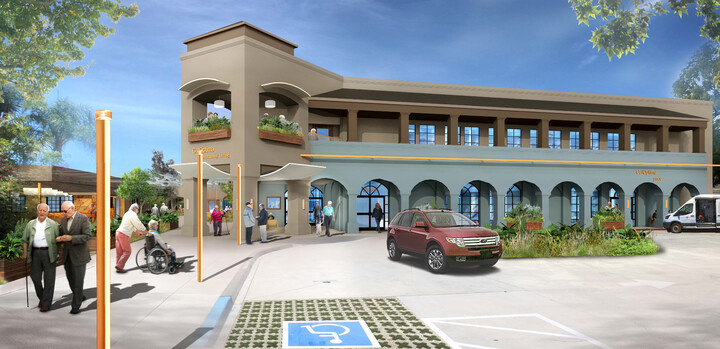
CalOptima Health, the provider of publicly funded health coverage in Orange County, is investing about $49 million to create the Community Living Center of Tustin, with the purpose of addressing challenges faced by the one of the county’s most vulnerable populations, those experiencing homelessness and aging.
From 2017 to 2021, the number of people 55 and older who accessed homeless-related services in Orange County increased by about 89%, according to the state’s Homeless Data Integration System. They are part of a growing “silver tsunami” of older adults who are falling into homelessness for the first time after the age of 50.
CalOptima is in the process of converting this building on Yorba Street in Tustin, CA to a senior facility for those 50 years old and older. (Photo by Paul Bersebach, Orange County Register/SCNG)
“A lot of it has to do with the financial crisis of 2008. The early baby boomers, they have good jobs and pensions and things of that nature, but the baby boomers toward the end of that generation oftentimes had lower paying jobs with no pensions … they were much more fragile financially,” said Kelly Bruno-Nelson, CalOptima’s executive director of Medi-Cal/CalAIM, adding that when the housing crisis hit, a lot of these people were pushed into the ballooning rental market. “So, they were one spouse dying or one job loss away from homelessness.”
Some who are struggling with homelessness use walkers or are in wheelchairs or are experiencing cognitive issues. They may need assistance with bathing or other daily needs. Because of that, Bruno-Nelson said there’s difficulty in figuring out where they can go.
“They can’t go to a shelter because shelters oftentimes have bunk beds, services are very far away. These individuals are in wheelchairs, but the hallways aren’t wide enough. They’re incontinent so they can’t wait to get to the restroom. There is no nursing. They can’t maneuver in a traditional shelter,” Bruno-Nelson said. “Recuperative care is for a short period of time and is also unlicensed. Because of that, they can’t help with bathing or with dressing. They can’t administer medications. So it’s really not much better.”
These shortcomings leave this population with two options: go to a nursing home prematurely, if an option, or live on the street. CalOptima wants to build a facility where the unhoused, aging group can find all the services they need under one roof.
The Community Living Center of Tustin will overhaul an existing building on Yorba Avenue to a combine recuperative care and the services of the already existing Program of All-Inclusive Care for the Elderly, also known as PACE.
All guests will be allowed to stay until they find stable, permanent housing, the agency said. CalOptima Health anticipates the average length of stay will be one year. Most guests will be exiting recuperative care facilities or hospitals. The center will not provide housing to individuals who do not need medical assistance or rehabilitation services.
The only individuals who will be eligible for the facility are adults 55 years or older who are unhoused and meet the medical criteria. The only way for an unhoused senior resident to get a bed in the center will be through a direct referral from a hospital, Tustin law enforcement or a shelter within the city of Tustin.
Overall, the recuperative care center will take care of 119 unhoused older adults working toward a permanent housing placement. The PACE center is expected to serve up to 500 individuals from both the surrounding community and the recuperative care center.
Each semi-private room will have its own bathroom and shower. The building will be divided into five “pods,” roughly 25 beds in each, that will be staffed with its own social worker and nurse, as well as a guest safety associate stationed 24 hours a day. Each pod will also have its own living room and space for socializing.
The facility will include an indoor gym, store, beauty salon and cyber café. PACE services include routine physicals, outpatient surgical and mental services, rehabilitation therapy and transportation services. The recuperative care program will provide additional services such as medication management, three meals a day, support in accessing benefits and interim housing until permanent housing is secured.
“The shelter system is not built for this population, it’s built for economy of scale. It’s built to serve as many folks as possible. It’s meant to serve a younger, more physically agile group of individuals,” Bruno-Nelson said, adding that this facility will be designed to serve the older residents in ways traditional shelters are not.
Bruno-Nelson said CalOptima is working with the city of Tustin now to get through the Planning Commission and have the project approved.
